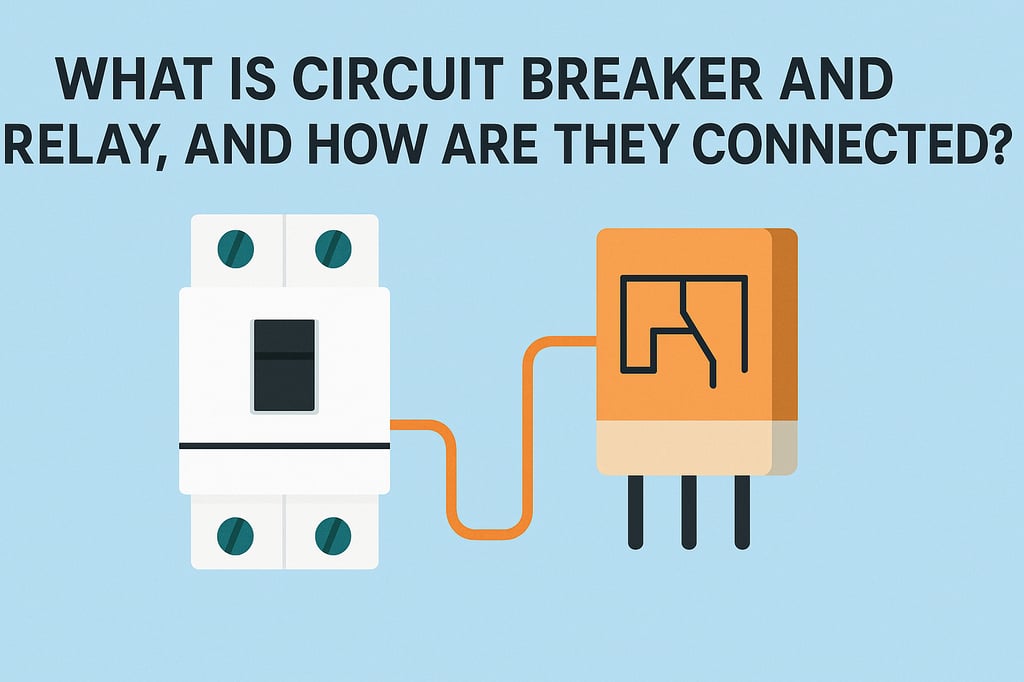What is Circuit Breaker and Relay, and How Are They Connected?
Learn what circuit breakers and relays do, how they differ, and how they work together to protect electrical systems.


What is Circuit Breaker and Relay and How Are They Connected?
(Circuit Breaker और Relay क्या होते हैं और ये कैसे जुड़े होते हैं?)
What is a Circuit Breaker (Circuit Breaker क्या होता है):
A Circuit Breaker is an automatic electrical switch designed to protect an electrical circuit from damage caused by overcurrent, short circuit, or overload. It interrupts the current flow when a fault is detected. It plays a vital role in ensuring the safety of electrical systems in homes, industries, and substations.
(Circuit Breaker एक automatic switch होता है जो किसी भी electrical fault जैसे overcurrent, short circuit, या overload के समय circuit को disconnect कर देता है, यह electrical circuit को damage से बचाने का काम करता है। यह घरों, फैक्ट्रियों और सबस्टेशन में electrical safety सुनिश्चित करने में महत्वपूर्ण भूमिका निभाता है।)
Types of Circuit Breakers:
MCB (Miniature Circuit Breaker): Used in residential and commercial buildings for low current protection. It trips during overload or short circuit conditions.
MCCB (Moulded Case Circuit Breaker): Suitable for higher current ratings, commonly used in industrial applications.
ACB (Air Circuit Breaker): Operates in air as the arc extinguishing medium, used in low voltage applications.
VCB (Vacuum Circuit Breaker): Uses vacuum to extinguish the arc, ideal for medium voltage systems.
SF6 Circuit Breaker: Uses sulfur hexafluoride gas for arc quenching, suitable for high voltage applications due to its excellent insulating properties.
Each type of breaker is selected based on the voltage level, current rating, and application environment.
What is a Relay (Relay क्या होता है):
A Relay is an electromagnetic switching device used to detect abnormal conditions in a circuit and send a trip signal to the circuit breaker. It does not break the circuit directly but acts as a sensing and control device. Relays are essential for automation and protection in electrical systems.
(Relay एक electromagnetic device है जो किसी circuit में fault आने पर उसे detect करता है और circuit breaker को trip करने का signal भेजता है। यह खुद से current को break नहीं करता, बल्कि एक control device की तरह काम करता है। यह electrical automation और protection के लिए बहुत जरूरी होता है।)
Types of Relays:
Overcurrent Relay- Detects excessive current flow beyond the set limit.
Earth Fault Relay- Identifies leakage current to the ground, preventing hazards.
Differential Relay- Compares current between two points and trips if there's a mismatch.
Voltage Relay- Monitors voltage levels and trips during under-voltage or over-voltage.
Directional Relay- Determines the direction of fault current, useful in complex networks.
How Are Circuit Breakers and Relays Connected?
The Relay is connected to Current Transformers (CTs) or Voltage Transformers (VTs) that monitor the circuit. These transformers step down high current or voltage to measurable levels for the relay.
When the relay detects a fault (like overcurrent or earth fault), it sends a trip signal to the Circuit Breaker. This signal is usually in the form of a low-voltage pulse that activates the tripping mechanism.
On receiving the signal, the Circuit Breaker trips and disconnects the faulty section of the system, preventing damage and ensuring safety.
(Relay को CT या VT से जोड़ा जाता है ताकि वह current या voltage की स्थिति को monitor कर सके। ये transformer relay को सही जानकारी देने में मदद करते हैं।) (जैसे ही relay को कोई fault detect होता है, यह एक trip signal circuit breaker को भेजता है। यह signal बहुत तेज़ी से भेजा जाता है ताकि system को नुकसान न हो।) (Circuit breaker वो signal मिलते ही तुरन्त trip होकर faulty section को अलग कर देता है। इससे बाकी system सुरक्षित रहता है।)
⚠️ Example in Power System:
In a substation, if an overcurrent occurs in a feeder line:
The relay detects it and instantly sends a trip signal.
The breaker receives the signal and opens the circuit within milliseconds.
This rapid response prevents transformer damage, fire hazards, and system failure.
Purpose of Relay + Circuit Breaker Combination:
Function Done by-
Fault detection – Relay: It senses the abnormal condition and decides when to act.
Power interruption – Circuit Breaker: It physically disconnects the circuit to stop current flow.
System protection – Both together: They work in tandem to protect equipment, maintain safety, and ensure reliability.
This combination is used in all major electrical installations, from homes to power plants, and is the backbone of electrical protection systems.
Conclusion (निष्कर्ष):
A Relay is the brain (detects fault).
A Circuit Breaker is the muscle (breaks the current).
Together, they ensure electrical safety and prevent equipment damage.
